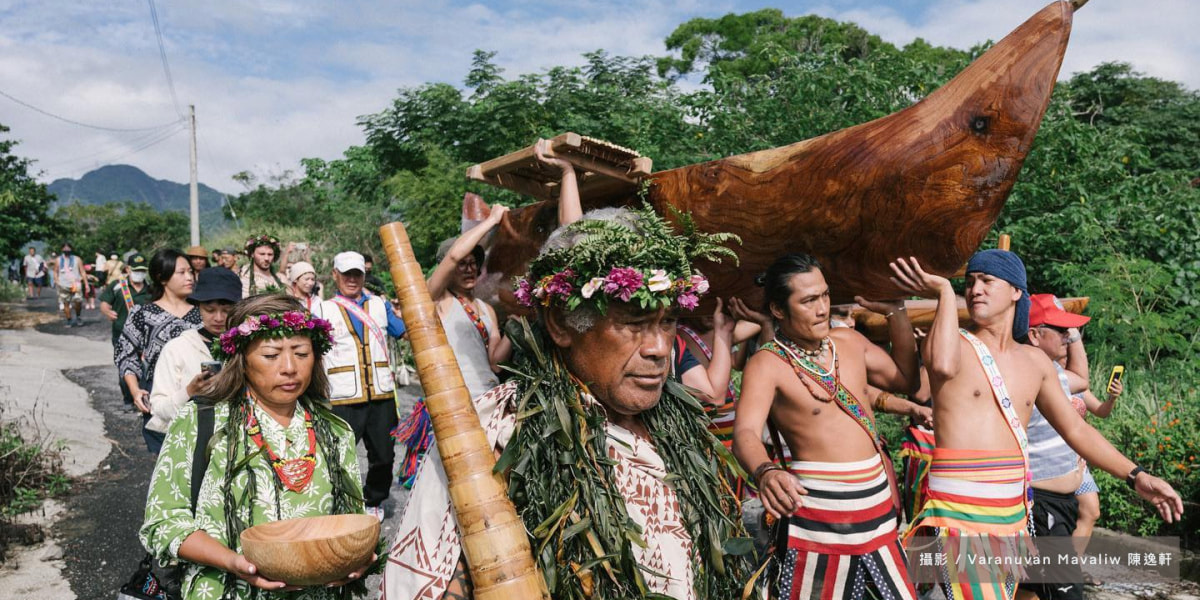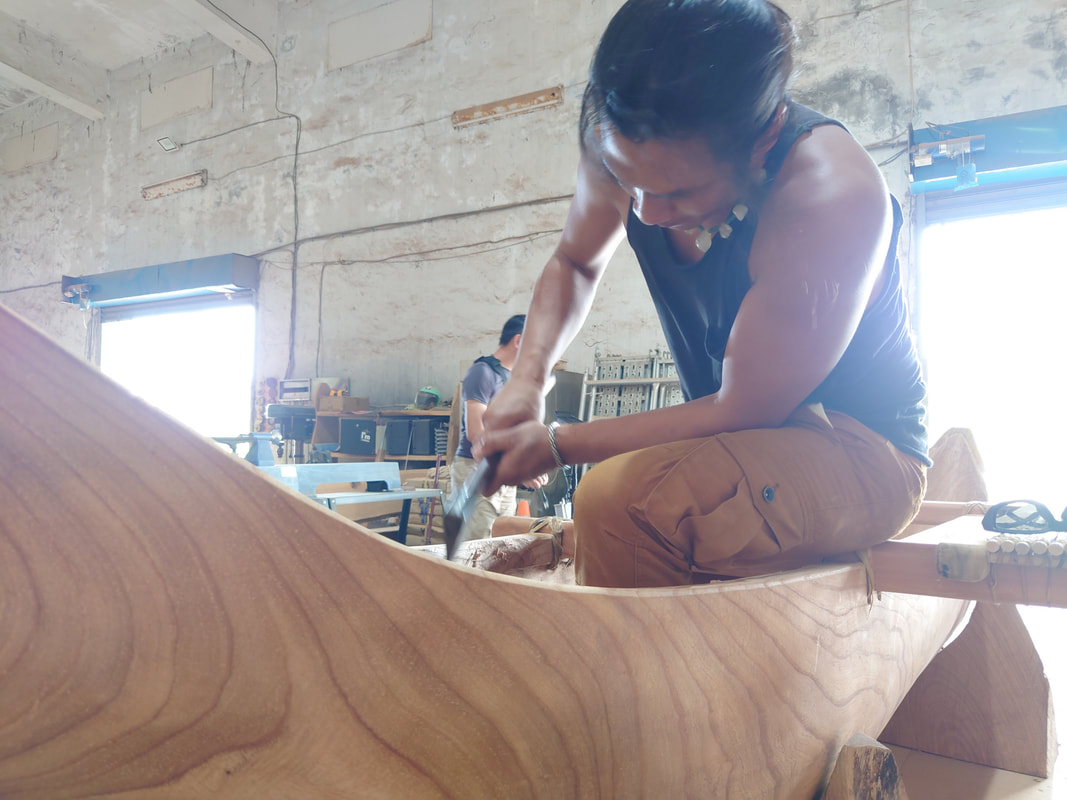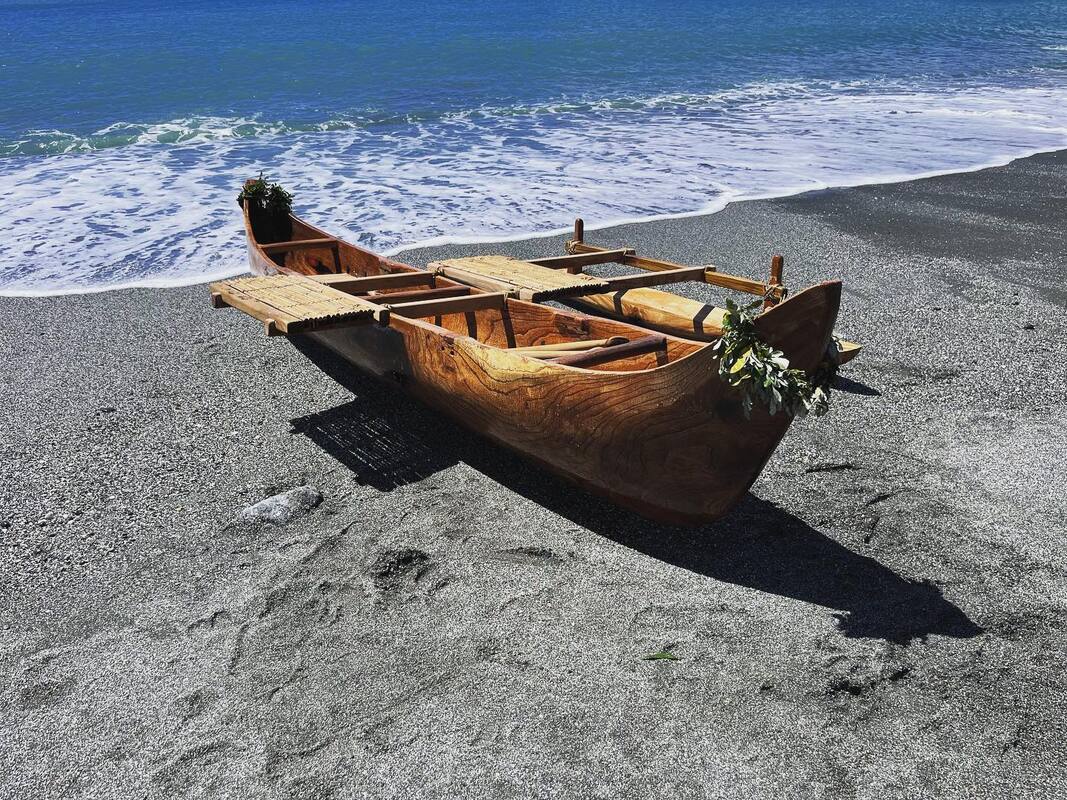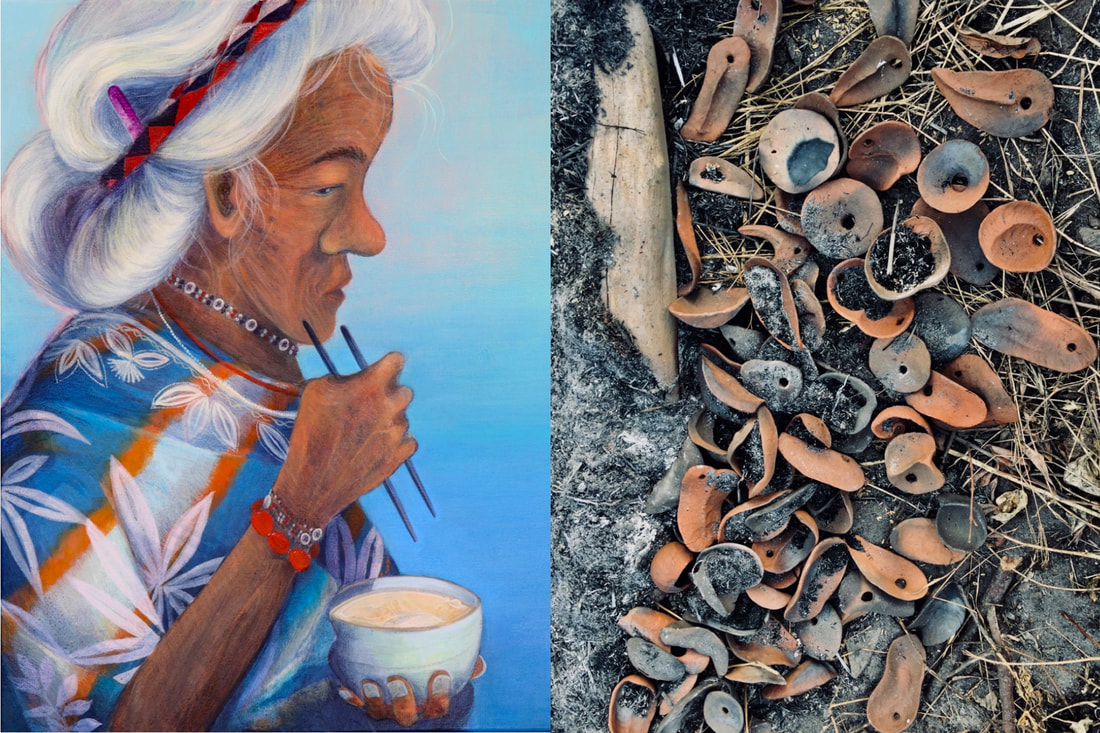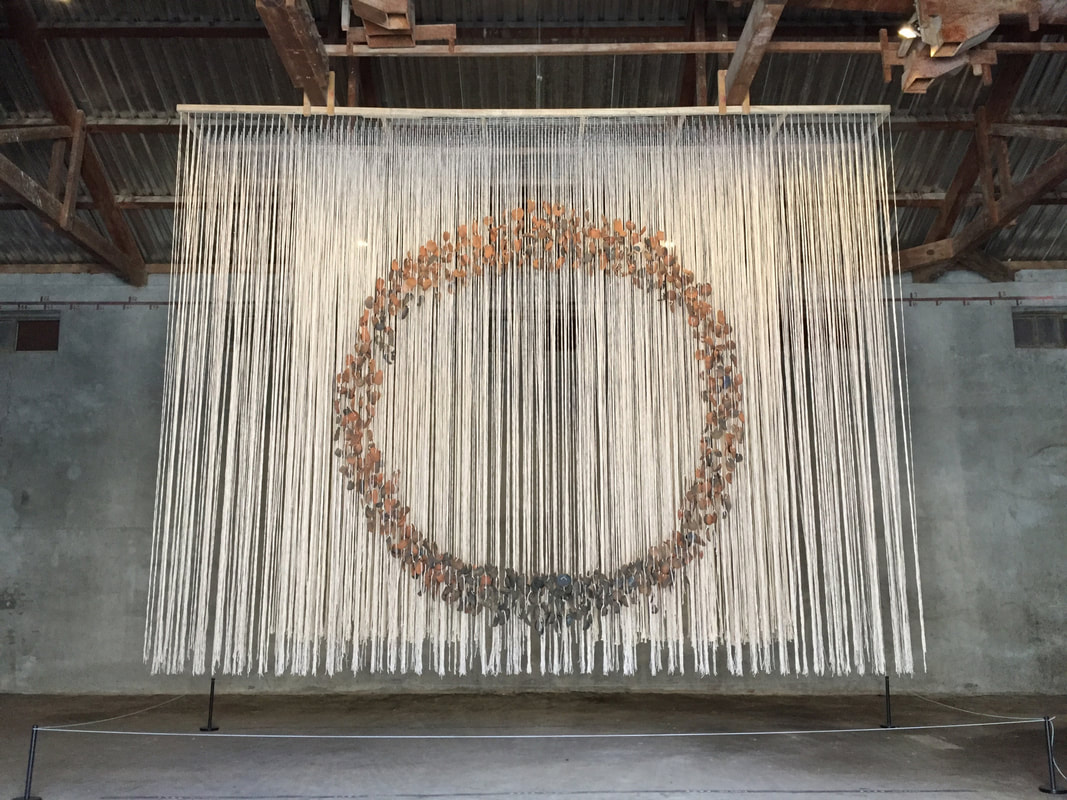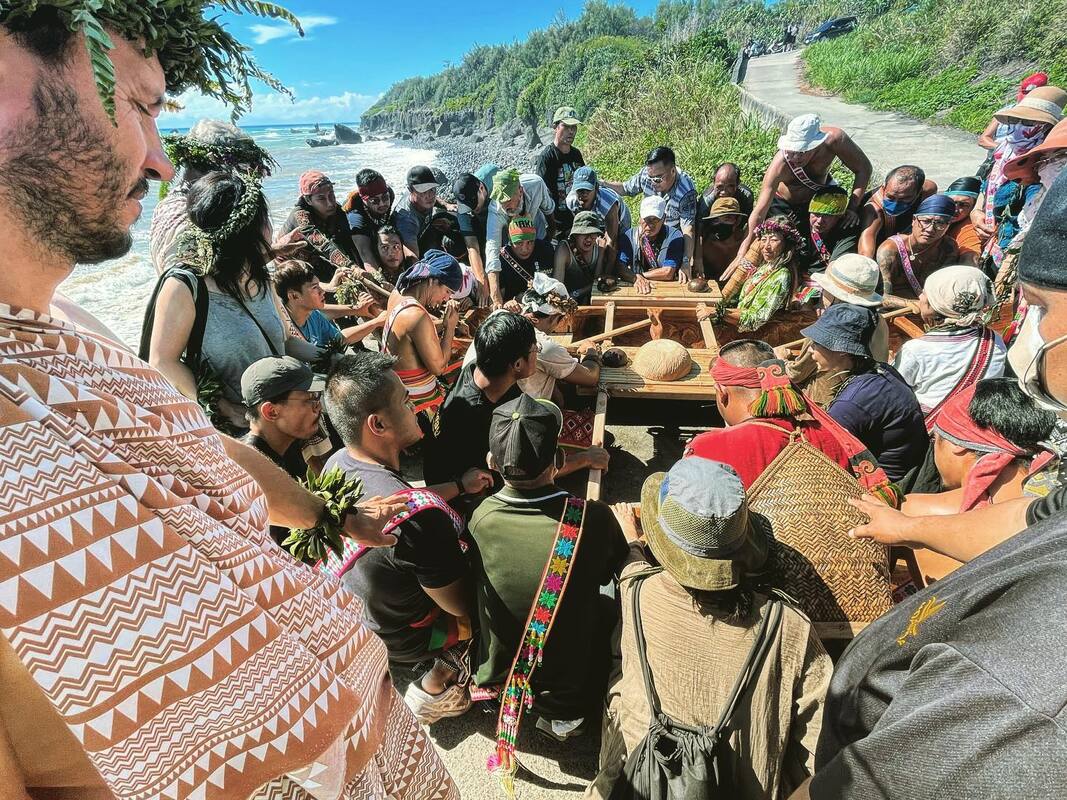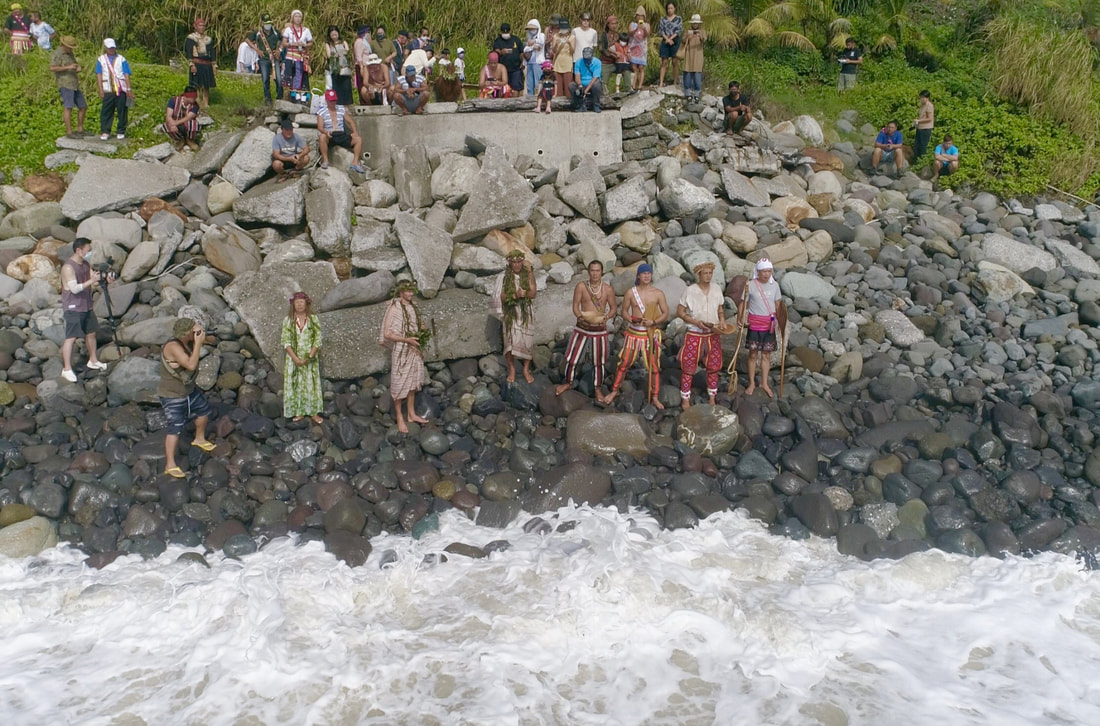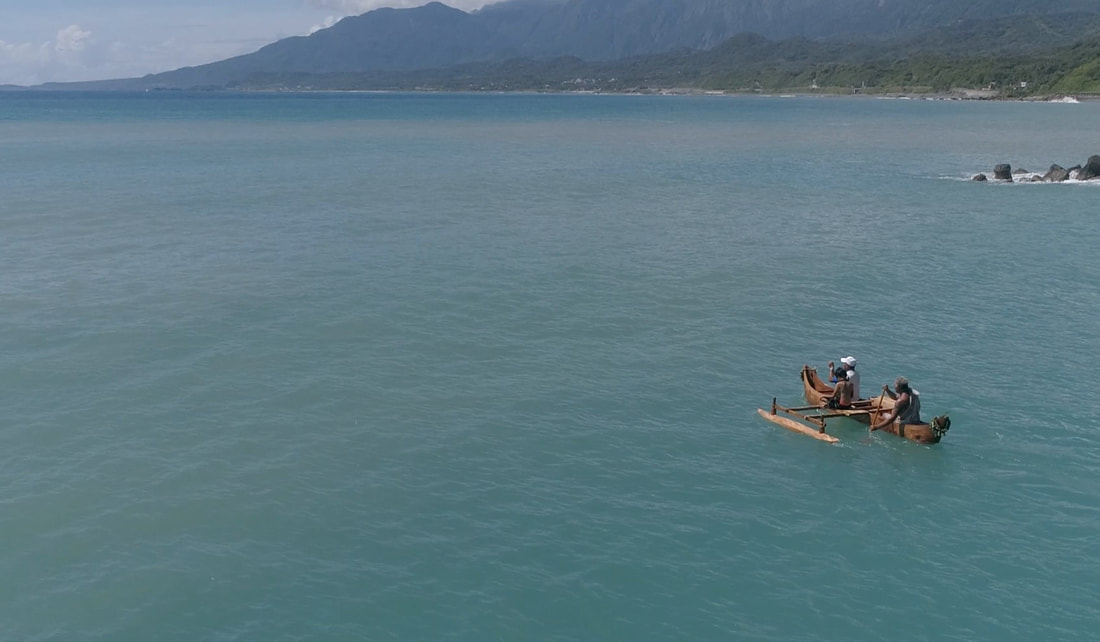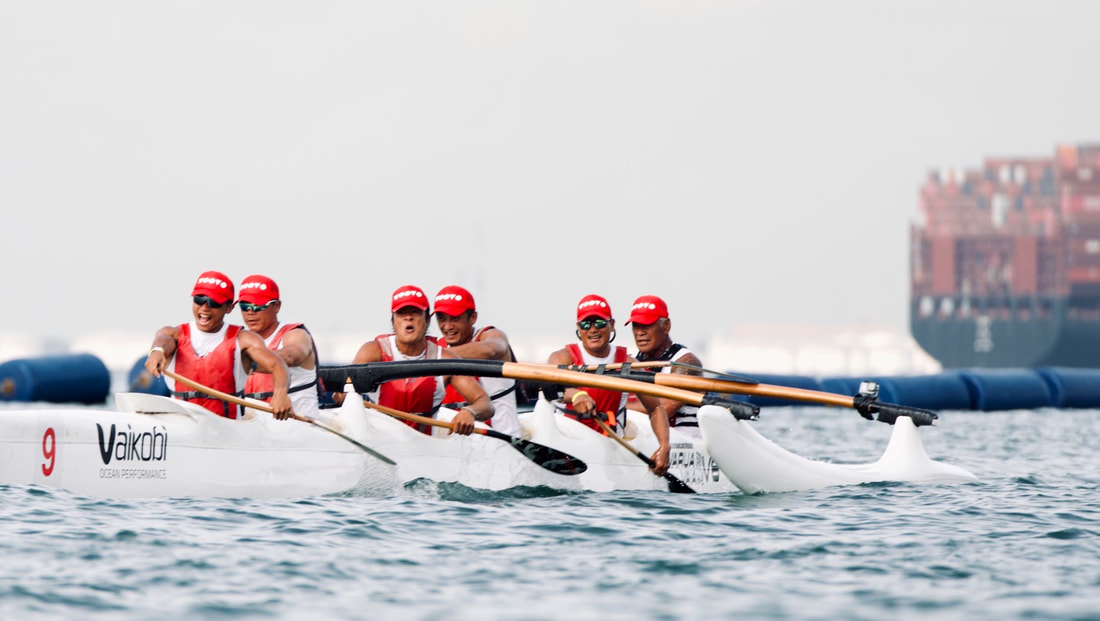Recovering the Amis Culture through Canoe and Pottery
Amis artist Lafin Sawmah envisioned a beautiful plan. It was to recover the Amis maritime culture by building and reconnecting with the canoe. Though not adept in canoeing, he practiced unceasingly for three months and was invited to join Taiwan's first outrigger canoe team, the “Taitung Austronesian,” together with other Taiwan indigenous peoples from different tribes to participate in the Singapore Ocean Cup “Race Without Waste” competition. "I want to inherit my ancestors' maritime expertise and their fearless and daring spirit," he said.
While he built a canoe, the significance of the project goes beyond the canoe. "Many of the South Pacific indigenous tribes have a tradition of canoe-building, including the Amis tribe. I want to use art to rediscover the Amis culture, to pass down our traditions, and to connect with more Austronesian peoples," he said.
Back in 2020, along Taiwan’s Provincial Highway 11 was a large warehouse that quietly housed a canoe. The canoe had many hand-carved marks on its body, still rough and untouched by seawater. This was Lafin's workshop located in Changbin. His ancestors were seafaring people, but today, it is rare to find someone with the knowhow to build a canoe. He chose a beautiful melia azedarach from the forests of Taiwan and, with the purest form of craftsmanship, carved the trunk into a four-meter-long canoe body.
Lafin is an Amis youth who returned to Changbin's Changguang tribe in 2009 after the devastating hit of Typhoon Morakot. That year, the beach was covered with driftwood brought down from the mountains by the typhoon. "The driftwood covered a large area of the sea, and the entire beach was filled with the scent of wood. You could smell it from the road," Lafin recalled. That year, Lafin left his job and began his apprenticeship to become a woodcarver.
While he built a canoe, the significance of the project goes beyond the canoe. "Many of the South Pacific indigenous tribes have a tradition of canoe-building, including the Amis tribe. I want to use art to rediscover the Amis culture, to pass down our traditions, and to connect with more Austronesian peoples," he said.
Back in 2020, along Taiwan’s Provincial Highway 11 was a large warehouse that quietly housed a canoe. The canoe had many hand-carved marks on its body, still rough and untouched by seawater. This was Lafin's workshop located in Changbin. His ancestors were seafaring people, but today, it is rare to find someone with the knowhow to build a canoe. He chose a beautiful melia azedarach from the forests of Taiwan and, with the purest form of craftsmanship, carved the trunk into a four-meter-long canoe body.
Lafin is an Amis youth who returned to Changbin's Changguang tribe in 2009 after the devastating hit of Typhoon Morakot. That year, the beach was covered with driftwood brought down from the mountains by the typhoon. "The driftwood covered a large area of the sea, and the entire beach was filled with the scent of wood. You could smell it from the road," Lafin recalled. That year, Lafin left his job and began his apprenticeship to become a woodcarver.
North of Provincial Highway 11 from Lafin's workshop, there is a renowned site, “Baxian Cave” also known as the “Eight Immortals Cave.” "When I first saw the Baxian Cave as a child, I didn't know what it was. I wondered if there were gods living inside," Lafin said. As he grew older, Lafin naturally knew that the Baxian Cave had nothing to do with the eight immortals; it was the discovery site of Changbin culture from the Paleolithic era.
"The first time I went to the site in Changbin, I remember feeling the power of the magnetic field. I had always believed that our ancestors held traditional rituals there," Lafin said. Then, Lafin asked a critical question, "Where did they go? Did they build canoes and paddle to the next place?"
Many studies have shown that the Austronesian language family ranges from Taiwan in the north to New Zealand in the south, Madagascar in the west, and Easter Island in the east. From linguistic, botanical, and anthropological evidence, Taiwan is likely the homeland and starting point of the Austronesian language family, representing a great human journey. "I am curious about how we, as the origin of Austronesian language family, interacted with the outside world. In building a canoe, can I find the answer? The courage and fearlessness of our ancestors can be inherited in such a way," Lafin said.
He spent the day working on the canoe and in his free time, he would "talk" to the canoe. He traveled to Orchid Island multiple times to learn the craft of canoe-making from the Tao people. Through physical labor, he established a connection with his ancestors. He invited tribesmen from the Puyuma and Rukai tribes to help adjust the balance of the canoe and tested it with his own tribesmen. "When it was nearly done, I felt the canoe was more than just a tool for navigation. As the Tao tribesmen say – it has a soul."
"The first time I went to the site in Changbin, I remember feeling the power of the magnetic field. I had always believed that our ancestors held traditional rituals there," Lafin said. Then, Lafin asked a critical question, "Where did they go? Did they build canoes and paddle to the next place?"
Many studies have shown that the Austronesian language family ranges from Taiwan in the north to New Zealand in the south, Madagascar in the west, and Easter Island in the east. From linguistic, botanical, and anthropological evidence, Taiwan is likely the homeland and starting point of the Austronesian language family, representing a great human journey. "I am curious about how we, as the origin of Austronesian language family, interacted with the outside world. In building a canoe, can I find the answer? The courage and fearlessness of our ancestors can be inherited in such a way," Lafin said.
He spent the day working on the canoe and in his free time, he would "talk" to the canoe. He traveled to Orchid Island multiple times to learn the craft of canoe-making from the Tao people. Through physical labor, he established a connection with his ancestors. He invited tribesmen from the Puyuma and Rukai tribes to help adjust the balance of the canoe and tested it with his own tribesmen. "When it was nearly done, I felt the canoe was more than just a tool for navigation. As the Tao tribesmen say – it has a soul."
Heidi – Rediscovering the tradition of making Amis pottery
While Lafin was working on the canoe, his wife, artist Heidi Yip, was also creating her own work. Changbin brought more than just the canoe to the young couple. The "Baxian Cave" was declared a national monument because archaeologists had discovered a large number of artifacts from the Old and New Stone Ages in the sea-eroded cave in Changbin. Heidi described it romantically, "We are modern people living on an ancient land."
Heidi is an artist born in Hong Kong and raised in Canada, who eventually settled in Taitung after marrying Lafin. The sunrise and sunset of Taitung's coastline, as well as the images of indigenous women, have all become inspirations for her art. "One time, while driving, a small truck suddenly braked in front of me and an indigenous lady wearing a style reminiscent of Yayoi Kusama got out of the car. The aesthetics of the indigenous people are expressed in their daily lives." Living in Taitung has allowed Heidi's artistic intuition develop into greater diversity and simplicity.
Especially during the past few years of living in Changbin, Heidi said, "Sometimes in the day, I will go digging and often come across pottery and bowls left behind by indigenous people in the shallow layers of the earth." This has led Heidi to wonder how she can use her art to preserve the traces of the indigenous people who once lived on this land.
While Lafin was working on the canoe, his wife, artist Heidi Yip, was also creating her own work. Changbin brought more than just the canoe to the young couple. The "Baxian Cave" was declared a national monument because archaeologists had discovered a large number of artifacts from the Old and New Stone Ages in the sea-eroded cave in Changbin. Heidi described it romantically, "We are modern people living on an ancient land."
Heidi is an artist born in Hong Kong and raised in Canada, who eventually settled in Taitung after marrying Lafin. The sunrise and sunset of Taitung's coastline, as well as the images of indigenous women, have all become inspirations for her art. "One time, while driving, a small truck suddenly braked in front of me and an indigenous lady wearing a style reminiscent of Yayoi Kusama got out of the car. The aesthetics of the indigenous people are expressed in their daily lives." Living in Taitung has allowed Heidi's artistic intuition develop into greater diversity and simplicity.
Especially during the past few years of living in Changbin, Heidi said, "Sometimes in the day, I will go digging and often come across pottery and bowls left behind by indigenous people in the shallow layers of the earth." This has led Heidi to wonder how she can use her art to preserve the traces of the indigenous people who once lived on this land.
In 2020, she was invited to create an art piece for the “Pioneering East Rift Valley Granary Festivities,” which provided her an excellent opportunity. She invited Amis pottery artist Hani Caki to assist her in using traditional Amis pottery-making techniques to create a work entitled "Revert to Earth."
To create the work, Heidi followed Hani to collect soil and dry it in the sun. She then invited several tribal women to the studio to pound and refine the soil, and they worked through the night to create the pottery piece in nature. "It was quite surprising how much manpower was needed to bring the work to life." The production method used was the same as thousands of years ago.
"'Revert to Earth' suspends hundreds of pottery pieces with hemp thread, creating a multi-layered circular space that is a spiritual ritual for humans to endlessly trace the land." Heidi said emotionally. Although they incorporated modern firing techniques into the work, Hani believes they are restoring the Amis pottery culture. "Changbin people live amid the cultural heritage of the Amis people, and perhaps some resonance from the ancestors is transmitted through the soil," she said.
Since the birth of "Revert to Earth", Heidi has continued to explore traditional Amis pottery-making methods, and has also held workshops in the studio, inviting friends who are interested in pottery to create using the soil from Changbin.
To create the work, Heidi followed Hani to collect soil and dry it in the sun. She then invited several tribal women to the studio to pound and refine the soil, and they worked through the night to create the pottery piece in nature. "It was quite surprising how much manpower was needed to bring the work to life." The production method used was the same as thousands of years ago.
"'Revert to Earth' suspends hundreds of pottery pieces with hemp thread, creating a multi-layered circular space that is a spiritual ritual for humans to endlessly trace the land." Heidi said emotionally. Although they incorporated modern firing techniques into the work, Hani believes they are restoring the Amis pottery culture. "Changbin people live amid the cultural heritage of the Amis people, and perhaps some resonance from the ancestors is transmitted through the soil," she said.
Since the birth of "Revert to Earth", Heidi has continued to explore traditional Amis pottery-making methods, and has also held workshops in the studio, inviting friends who are interested in pottery to create using the soil from Changbin.
“This canoe has a soul, and it tells me not to be afraid.” - Lafin
By the end of September 2022, after several modifications and tests, Lafin's canoe finally confirmed its official launch date. On that day, in the early morning around 7 o'clock, young tribespeople wearing traditional clothing from various indigenous tribes such as the Paiwan, Rukai, and Tao, arrived at the activity center of the Changguang Tribe one after another. For this grand day, some brought their entire family. The small activity center was filled with an eager anticipation.
Facing the scorching morning sun of Taitung, more than ten tribal youths carried the four-meter-long dugout canoe step by step towards the seashore of the Changguang Tribe. "I told the tribal leaders and elders that I wanted to hold a blessing ceremony for the canoe, and actually, this hasn't been held in the tribe for a long time," Lafin said.
This type of blessing ceremony returning to the tribe has significant meaning for Lafin. Taiwan indigenous people have always offered rice wine and betel nuts to pray to their ancestors and to give thanks to all things before entering the mountains to hunt or fish in the sea. What is special this time is that Kimokeo Kapahulehua, a Hawai’ian national treasure and master of navigation, also came to Taiwan to bless the canoe. He said that their ancestors set sail from Taiwan 7,000 years ago and sailed to settle in the Hawai’ian Islands. This time, he was invited to bless the new canoe of the Amis tribe, "like coming home." He led Lafin and the tribal people who built the canoe together to the seashore to pray to the ocean. "We invite the ancestors of the sky and the sea to be with us, please bless us, and witness this moment together," he said.
By the end of September 2022, after several modifications and tests, Lafin's canoe finally confirmed its official launch date. On that day, in the early morning around 7 o'clock, young tribespeople wearing traditional clothing from various indigenous tribes such as the Paiwan, Rukai, and Tao, arrived at the activity center of the Changguang Tribe one after another. For this grand day, some brought their entire family. The small activity center was filled with an eager anticipation.
Facing the scorching morning sun of Taitung, more than ten tribal youths carried the four-meter-long dugout canoe step by step towards the seashore of the Changguang Tribe. "I told the tribal leaders and elders that I wanted to hold a blessing ceremony for the canoe, and actually, this hasn't been held in the tribe for a long time," Lafin said.
This type of blessing ceremony returning to the tribe has significant meaning for Lafin. Taiwan indigenous people have always offered rice wine and betel nuts to pray to their ancestors and to give thanks to all things before entering the mountains to hunt or fish in the sea. What is special this time is that Kimokeo Kapahulehua, a Hawai’ian national treasure and master of navigation, also came to Taiwan to bless the canoe. He said that their ancestors set sail from Taiwan 7,000 years ago and sailed to settle in the Hawai’ian Islands. This time, he was invited to bless the new canoe of the Amis tribe, "like coming home." He led Lafin and the tribal people who built the canoe together to the seashore to pray to the ocean. "We invite the ancestors of the sky and the sea to be with us, please bless us, and witness this moment together," he said.
"Thank you to our ancestors for leaving their wisdoms in my blood and flesh, thank you to our friends and brothers from different indigenous tribes, thank you to this land and this ocean, thank you everyone," Lafin said with a choked voice.
After the blessing ceremony, the tribal youths once again lifted the canoe and slowly moved towards the sea. Along the way, someone began to sing tribal songs that elders once sang together during times of labor.
This was the first canoe that Lafin had built. He said, "During the building process, I had many worries and concerns. I was even afraid whether it would have good water resistance, and whether it could take me out to sea."
After the blessing ceremony, the tribal youths once again lifted the canoe and slowly moved towards the sea. Along the way, someone began to sing tribal songs that elders once sang together during times of labor.
This was the first canoe that Lafin had built. He said, "During the building process, I had many worries and concerns. I was even afraid whether it would have good water resistance, and whether it could take me out to sea."
Everyone waded into the bay near the Changbin Fishing Port and gently placed the canoe on the sea. Lafin took the hand of his son from the crowd, and successfully boarded the wooden canoe. Lafin smoothly paddled the oars and the light canoe broke through the water and headed towards the open sea. The sound of cheers from the shore and the horn that Kimokeo Kapahulehua blew for them could be heard from afar.
"Go to Orchid Island! Go to Orchid Island! We are waiting for you on Orchid Island!" shouted their friends from the Tao tribe in excitement.
Lafin rowed the canoe with ease, as if it came naturally to him. "When I paddle this canoe, it makes me feel at ease. I am no longer afraid or worried. Because this canoe has a soul, and it tells me not to be afraid," Lafin said. His son even stood up on the canoe and raised his arms, accepting the cheers of the people.
This day was a long-awaited event for Lafin and his tribe. Lafin slaughtered a pig and held a feast, thanking the brothers, sisters, and elders from various tribes who made the event possible. As people gathered in a circle, someone started to sing, and everyone joined in to sing and dance in celebration of this unforgettable moment.
"Go to Orchid Island! Go to Orchid Island! We are waiting for you on Orchid Island!" shouted their friends from the Tao tribe in excitement.
Lafin rowed the canoe with ease, as if it came naturally to him. "When I paddle this canoe, it makes me feel at ease. I am no longer afraid or worried. Because this canoe has a soul, and it tells me not to be afraid," Lafin said. His son even stood up on the canoe and raised his arms, accepting the cheers of the people.
This day was a long-awaited event for Lafin and his tribe. Lafin slaughtered a pig and held a feast, thanking the brothers, sisters, and elders from various tribes who made the event possible. As people gathered in a circle, someone started to sing, and everyone joined in to sing and dance in celebration of this unforgettable moment.
Closing Remarks
March 2023, ACF interviewed Lafin over the phone to check on his recent status. At the moment, Lafin is participating in an exchange activity in New Zealand, which is related to the maritime culture of the Austronesian peoples. He said, "I came in fourth place in the individual competition of the Singapore Ocean Cup, but before the competition, I didn't really know how to paddle. My path is contrary to others, in that I built a canoe before learning how to paddle; however, the oceanic wisdoms in my genes passed down by our ancestors are still within me." This year, Lafin plans to further develop the canoe so that it can sail with the wind. He hopes to first sail to Orchid Island and Green Island, and then move on to the Philippines and Indonesia. On the other hand, Lafin still has a practical side and said that he needs to make money during the day to have time to carry out this plan.
He said emotionally, "What our ancestors gave us is too beautiful. Through this canoe, I seem to know what to do next. I hope that the next generation will be able to preserve our maritime culture."
March 2023, ACF interviewed Lafin over the phone to check on his recent status. At the moment, Lafin is participating in an exchange activity in New Zealand, which is related to the maritime culture of the Austronesian peoples. He said, "I came in fourth place in the individual competition of the Singapore Ocean Cup, but before the competition, I didn't really know how to paddle. My path is contrary to others, in that I built a canoe before learning how to paddle; however, the oceanic wisdoms in my genes passed down by our ancestors are still within me." This year, Lafin plans to further develop the canoe so that it can sail with the wind. He hopes to first sail to Orchid Island and Green Island, and then move on to the Philippines and Indonesia. On the other hand, Lafin still has a practical side and said that he needs to make money during the day to have time to carry out this plan.
He said emotionally, "What our ancestors gave us is too beautiful. Through this canoe, I seem to know what to do next. I hope that the next generation will be able to preserve our maritime culture."
The article was an interview by Huang Hui-ling, translated from Chinese to English by Chat GPT.

